Celiac trunk anatomy
Download as pptx, pdf0 likes765 views
different anatomical variant of celiac trunk and methods of visualisation. Report from meeting of surgical club "Armata manus". Author: Buhensky Andrey
1 of 23
Download to read offline

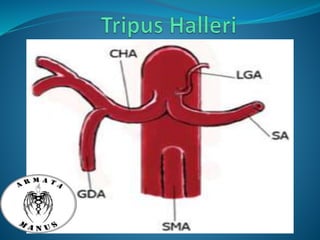
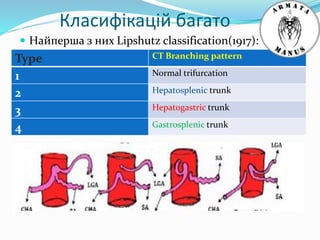
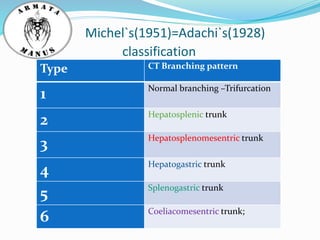




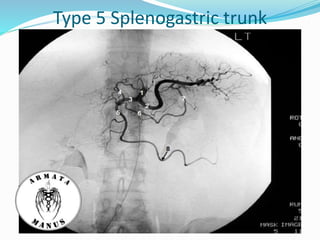


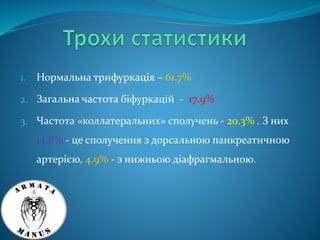
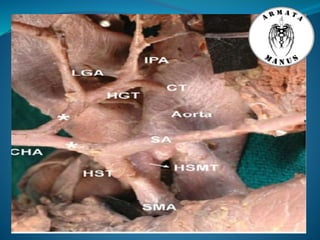
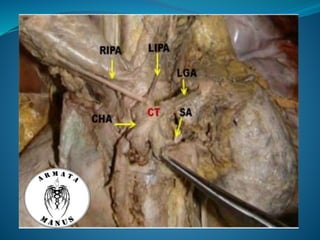
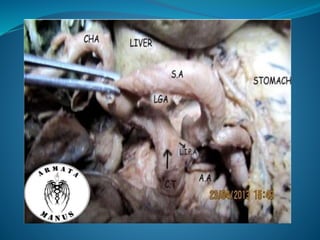
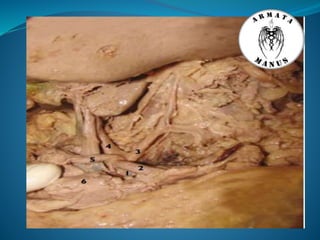


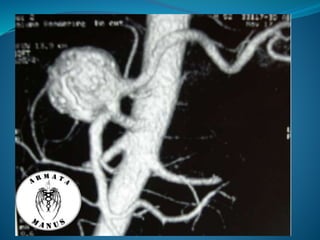
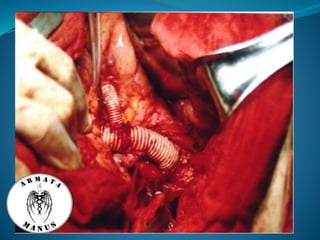

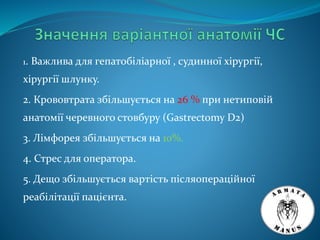

Ad
Recommended
ą£ąŠą╗ąĄą║čāą╗čÅčĆąĮą░ čäč¢ąĘč¢ąŠą╗ąŠą│č¢čÅ ą┤ąĖčģą░ąĮąĮčÅ
ą£ąŠą╗ąĄą║čāą╗čÅčĆąĮą░ čäč¢ąĘč¢ąŠą╗ąŠą│č¢čÅ ą┤ąĖčģą░ąĮąĮčÅVictor Dosenko
╠²
ąøąĄą║čåč¢čÅ ą┐čĆąŠč乥čüąŠčĆą░ ąöąŠčüąĄąĮą║ą░ ąÆ,ąä. ąĘ ą║čāčĆčüčā ą╝ąŠą╗ąĄą║čāą╗čÅčĆąĮąŠčŚ čäč¢ąĘč¢ąŠą╗ąŠą│č¢čŚ čäą░ą║čāą╗čīč鹥čéčā čäč¢ąĘąĖą║ąĖ ąČąĖą▓ąĖčģ čüąĖčüč鹥ą╝ ąØąóąŻ "ąÜą¤ąå"ąÜąŠąĮčüąĄčĆą▓ą░čéąĖą▓ąĮąĄ ą╗č¢ą║čāą▓ą░ąĮąĮčÅ čüą┐ąŠąĮčéą░ąĮąĮąŠą│ąŠ ą│ąĄą╝ąŠą┐ąĄčĆąĖč鹊ąĮąĄčāą╝čā (ą┤ąŠą┐ąŠą▓č¢ą┤ą░čć ą¤ąŠą┐ą░ąĮą┤ąŠą┐ą░ą╗ąŠ ą×.ą×.)
ąÜąŠąĮčüąĄčĆą▓ą░čéąĖą▓ąĮąĄ ą╗č¢ą║čāą▓ą░ąĮąĮčÅ čüą┐ąŠąĮčéą░ąĮąĮąŠą│ąŠ ą│ąĄą╝ąŠą┐ąĄčĆąĖč鹊ąĮąĄčāą╝čā (ą┤ąŠą┐ąŠą▓č¢ą┤ą░čć ą¤ąŠą┐ą░ąĮą┤ąŠą┐ą░ą╗ąŠ ą×.ą×.)Dmitriy Shamrai
╠²
ąöąŠą┐ąŠą▓č¢ą┤čī ą¤ąŠą┐ą░ąĮą┤ąŠą┐ą░ą╗ąŠ ą×.ą×., čÅą║ą░ ą▒čāą╗ą░ ą┐čĆąŠčćąĖčéą░ąĮą░ čā čĆą░ą╝ą║ą░čģ VI (68) ą£ąåą¢ąØąÉąĀą×ąöąØą×ąōą× ąØąÉąŻąÜą×ąÆą×-ą¤ąĀąÉąÜąóąśą¦ąØą×ąōą× ąÜą×ąØąōąĀąĢąĪąŻ ąĪąóąŻąöąĢąØąóąåąÆ ąóąÉ ą£ą×ąøą×ąöąśąź ąÆą¦ąĢąØąśąź ┬½ąÉąÜąóąŻąÉąøą¼ąØąå ą¤ąĀą×ąæąøąĢą£ąś ąĪąŻą¦ąÉąĪąØą×ąć ą£ąĢąöąśą”ąśąØąś┬╗, 15-17 ą¢ą×ąÆąóąØą» 2014 ąĀą×ąÜąŻąÜąŠą╝ą┐'čÄč鹥čĆąĮą░ č鹥čģąĮč¢ą║ą░ ą▓ ą╝ąĄą┤ąĖčåąĖąĮč¢
ąÜąŠą╝ą┐'čÄč鹥čĆąĮą░ č鹥čģąĮč¢ą║ą░ ą▓ ą╝ąĄą┤ąĖčåąĖąĮč¢innagrabobska
╠²
ąÆąĖą║ąŠčĆąĖčüčéą░ąĮąĮčÅ ą║ąŠą╝ą┐'čÄč鹥čĆąĮąŠčŚ č鹥čģąĮč¢ą║ąĖ ą▓ ą╝ąĄą┤ąĖčåąĖąĮč¢Anatomy of liver hilum
Anatomy of liver hilumDmitriy Shamrai
╠²
Variant anatomy of arteria hepatica propria, portal vein, hepatic ducts, livet plates. Examples on schemes, intraoperative fotos, visualisation methods.
Report from meeting of surgical club "Armata manus".
Author: Shpichka Glib (ą©ą┐ąĖčćą║ą░ ąōą╗č¢ą▒)ą┐ą░č鹊ą╗ąŠą│č¢čÅ čéą║ą░ąĮąĖąĮąĮąŠą│ąŠ čĆąŠčüčéčā ą┐čāčģą╗ąĖąĮą░
ą┐ą░č鹊ą╗ąŠą│č¢čÅ čéą║ą░ąĮąĖąĮąĮąŠą│ąŠ čĆąŠčüčéčā ą┐čāčģą╗ąĖąĮą░Victor Dosenko
╠²
ąÜą░č乥ą┤čĆą░ ą┐ą░č鹊ą╗ąŠą│č¢čćąĮąŠčŚ čäč¢ąĘč¢ąŠą╗ąŠą│č¢čŚ ąØą£ąŻ č¢ą╝. ą×.ą×.ąæąŠą│ąŠą╝ąŠą╗čīčåčÅ, ąÜąĖ茹▓, ąŻą║čĆą░茹Įą░ą┐ą░č鹊čäč¢ąĘč¢ąŠą╗ąŠą│č¢čÅ ąĘąŠą▓ąĮč¢čłąĮčīąŠą│ąŠ ą┤ąĖčģą░ąĮąĮčÅ
ą┐ą░č鹊čäč¢ąĘč¢ąŠą╗ąŠą│č¢čÅ ąĘąŠą▓ąĮč¢čłąĮčīąŠą│ąŠ ą┤ąĖčģą░ąĮąĮčÅVictor Dosenko
╠²
ąÜą░č乥ą┤čĆą░ ą┐ą░č鹊čäč¢ąĘč¢ąŠą╗ąŠą│č¢čŚ ąØą£ąŻ č¢ą╝. ą×.ą×.ąæąŠą│ąŠą╝ąŠą╗čīčåčÅ, ąÜąĖ茹▓, ąŻą║čĆą░茹Įą░ąźčĆąŠąĮč¢čćąĮč¢ ąŠą▒čüčéčĆčāą║čéąĖą▓ąĮč¢ ąĘą░čģą▓ąŠčĆčÄą▓ą░ąĮąĮčÅ ą╗ąĄą│ąĄąĮčī
ąźčĆąŠąĮč¢čćąĮč¢ ąŠą▒čüčéčĆčāą║čéąĖą▓ąĮč¢ ąĘą░čģą▓ąŠčĆčÄą▓ą░ąĮąĮčÅ ą╗ąĄą│ąĄąĮčīVictor Dosenko
╠²
ąøąĄą║čåč¢čÅ ąĘ ą┐ą░č鹊ą╗ąŠą│č¢čćąĮąŠčŚ čäč¢ąĘč¢ąŠą╗ąŠą│č¢čŚRespiratory System / ąöąĖčģą░ą╗čīąĮą░ čüąĖčüč鹥ą╝ą░
Respiratory System / ąöąĖčģą░ą╗čīąĮą░ čüąĖčüč鹥ą╝ą░Alla Khodorovska
╠²
Lection about Histology of the Respiratory System / ąøąĄą║čåč¢čÅ ąĮą░ č鹥ą╝čā "ąōč¢čüč鹊ą╗ąŠą│č¢čÅ ą┤ąĖčģą░ą╗čīąĮąŠčŚ čüąĖčüč鹥ą╝ąĖ" (Author / ąÉą▓č鹊čĆ - Khodorovska Alla / ąźąŠą┤ąŠčĆąŠą▓čüčīą║ą░ ąÉą╗ą╗ą░)Hepatic arterial anatomy and vascular optimization final
Hepatic arterial anatomy and vascular optimization finalpryce27
╠²
1. This document summarizes hepatic arterial anatomy and variants based on a review of over 600 angiograms.
2. It describes the typical hepatic arterial anatomy and variants including replaced or accessory left/right hepatic arteries. Accessory arteries usually supply a distinct territory.
3. Extrahepatic collateral arteries are discussed which can supply hepatocellular carcinoma, including the phrenic, omental, intercostal, and adrenal arteries. Recognition of these collateral arteries is important to avoid complications during embolization.Omentum ŌĆō anatomy, pathological conditions and surgical importance
Omentum ŌĆō anatomy, pathological conditions and surgical importanceAravind Endamu
╠²
The omentum is a fold of tissue that hangs down from the stomach and extends over other abdominal organs. It has important functions like immunity, absorbing edema, and limiting spread of infection. The greater omentum develops from the dorsal mesogastrium and extends from the stomach to the transverse colon. The lesser omentum connects the stomach and duodenum to the liver. Pathologies of the omentum include cysts, torsion, and tumors. Clinically, the omentum helps drain collections, access the retroperitoneum surgically, and forms adhesions useful for patching perforations.Tracheostomy (čéčĆą░čģąĄąŠčüč鹊ą╝ąĖčÅ)
Tracheostomy (čéčĆą░čģąĄąŠčüč鹊ą╝ąĖčÅ)Dmitriy Shamrai
╠²
ąöąŠą║čāą╝ąĄąĮčé ąŠą▒čüčāąČą┤ą░ąĄčé čĆą░ąĘą╗ąĖčćąĮčŗąĄ ą╝ąĄč鹊ą┤čŗ čéčĆą░čģąĄąŠčüč鹊ą╝ąĖąĖ, ą▓ą║ą╗čÄčćą░čÅ čģąĖčĆčāčĆą│ąĖč湥čüą║čāčÄ ąĖ čćčĆąĄčüą║ąŠąČąĮčāčÄ ą┤ąĖą╗čÅčéą░čåąĖąŠąĮąĮčāčÄ čéčĆą░čģąĄąŠčüč鹊ą╝ąĖčÄ, ąĖčģ ą┐ąŠą║ą░ąĘą░ąĮąĖčÅ, ą┐čĆąĄąĖą╝čāčēąĄčüčéą▓ą░ ąĖ ąĮąĄą┤ąŠčüčéą░čéą║ąĖ. ą×čüąĮąŠą▓ąĮąŠąĄ ą▓ąĮąĖą╝ą░ąĮąĖąĄ čāą┤ąĄą╗čÅąĄčéčüčÅ čĆą░ąĮąĮąĖą╝ ąĖ ą┐ąŠąĘą┤ąĮąĖą╝ ąŠčüą╗ąŠąČąĮąĄąĮąĖčÅą╝, ą░ čéą░ą║ąČąĄ čüčĆąŠą║ą░ą╝ ą▓čŗą┐ąŠą╗ąĮąĄąĮąĖčÅ čéčĆą░čģąĄąŠčüč鹊ą╝ąĖąĖ čā ą┐ą░čåąĖąĄąĮč鹊ą▓ ąĮą░ ąśąÆąø. ąóą░ą║ąČąĄ čĆą░čüčüą╝ą░čéčĆąĖą▓ą░čÄčéčüčÅ ąĖčüčüą╗ąĄą┤ąŠą▓ą░ąĮąĖčÅ, ą┐ąŠą┤čéą▓ąĄčƹȹ┤ą░čÄčēąĖąĄ ą┐čĆąĄąĖą╝čāčēąĄčüčéą▓ąŠ čĆą░ąĮąĮąĄą╣ čéčĆą░čģąĄąŠčüč鹊ą╝ąĖąĖ ą▓ čüąĮąĖąČąĄąĮąĖąĖ čüą╝ąĄčĆčéąĮąŠčüčéąĖ ąĖ ą▓čĆąĄą╝ąĄąĮąĖ ąĮą░ ąśąÆąø.Liver Trauma (Liver Injury)
Liver Trauma (Liver Injury)Dmitriy Shamrai
╠²
ąöąŠą║čāą╝ąĄąĮčé čĆą░čüčüą╝ą░čéčĆąĖą▓ą░ąĄčé ą╝ąĄč鹊ą┤čŗ čģąĖčĆčāčĆą│ąĖč湥čüą║ąŠą│ąŠ ą▓ą╝ąĄčłą░č鹥ą╗čīčüčéą▓ą░ ą┐čĆąĖ čéčĆą░ą▓ą╝ą░čģ ą┐ąĄč湥ąĮąĖ, ą▓ čćą░čüčéąĮąŠčüčéąĖ, ą┐čĆąĖ ą┐čĆąŠąĮąĖą║ą░čÄčēąĖčģ čĆą░ąĮąĄąĮąĖčÅčģ ąĖ ą│ąĄą╝ąŠčĆčĆą░ą│ąĖč湥čüą║ąŠą╝ čłąŠą║ąĄ. ą×ą┐ąĖčüčŗą▓ą░čÄčéčüčÅ čĆą░ąĘą╗ąĖčćąĮčŗąĄ čéąĖą┐čŗ čéčĆą░ą▓ą╝, ąĖčģ čģą░čĆą░ą║č鹥čĆąĖčüčéąĖą║ąĖ ą┐ąŠ čĆąĄąĘčāą╗čīčéą░čéą░ą╝ ąÜąó ąĖ ą╝ąĄč鹊ą┤čŗ ąĮąĄąŠą┐ąĄčĆą░čéąĖą▓ąĮąŠą│ąŠ ąĖ ąŠą┐ąĄčĆą░čéąĖą▓ąĮąŠą│ąŠ ą╗ąĄč湥ąĮąĖčÅ. ąóą░ą║ąČąĄ ąŠą▒čüčāąČą┤ą░čÄčéčüčÅ č鹥čģąĮąĖą║ąĖ čāą┐čĆą░ą▓ą╗ąĄąĮąĖčÅ ą║čĆąŠą▓ąŠč鹥č湥ąĮąĖčÅą╝ąĖ ąĖ ą▓ąŠąĘą╝ąŠąČąĮąŠčüčéąĖ čāą┐čĆą░ą▓ą╗ąĄąĮąĖčÅ čüčĆąĄą┤čüčéą▓ą░ą╝ąĖ, čéą░ą║ąĖą╝ąĖ ą║ą░ą║ ą╝ą░ąĮąĄą▓čĆ ą¤čĆąĖąĮą│ą╗ą░ ąĖ ą┐ąĄčĆąĖą┐ąĄč湥ąĮąŠčćąĮąŠąĄ čéą░ą╝ą┐ąŠąĮąĖčĆąŠą▓ą░ąĮąĖąĄ.ąŁąĮč鹥čĆąŠčŹąĮč鹥čĆąŠą░ąĮą░čüč鹊ą╝ąŠąĘ ąĮą░ ą║čĆąŠą╗ąĖą║ąĄ ą║ą░ą║ čüčéą░ą┤ąĖčÅ ąŠą▒čāč湥ąĮąĖąĄ č鹥čģąĮąĖą║ąĄ čüąŠčüčāą┤ąĖčüč鹊ą│ąŠ čłą▓ą░
ąŁąĮč鹥čĆąŠčŹąĮč鹥čĆąŠą░ąĮą░čüč鹊ą╝ąŠąĘ ąĮą░ ą║čĆąŠą╗ąĖą║ąĄ ą║ą░ą║ čüčéą░ą┤ąĖčÅ ąŠą▒čāč湥ąĮąĖąĄ č鹥čģąĮąĖą║ąĄ čüąŠčüčāą┤ąĖčüč鹊ą│ąŠ čłą▓ą░Dmitriy Shamrai
╠²
ąöąŠą║čāą╝ąĄąĮčé ąŠą▒čüčāąČą┤ą░ąĄčé ąŠą▒čāč湥ąĮąĖąĄ č鹥čģąĮąĖą║ąĄ čüąŠčüčāą┤ąĖčüč鹊ą│ąŠ čłą▓ą░ ąĮą░ ą║čĆąŠą╗ąĖą║ą░čģ ą║ą░ą║ ą║čĆąĖčéąĖč湥čüą║ąĖą╣ čŹčéą░ą┐ ą┐ąŠą┤ą│ąŠč鹊ą▓ą║ąĖ čģąĖčĆčāčĆą│ąŠą▓, ą┐ąŠą┤č湥čĆą║ąĖą▓ą░čÅ ą▓ą░ąČąĮąŠčüčéčī ą╝ą░ąĮčāą░ą╗čīąĮčŗčģ ąĮą░ą▓čŗą║ąŠą▓ ą┤ą╗čÅ ą║ą░č湥čüčéą▓ąĄąĮąĮąŠą╣ čģąĖčĆčāčĆą│ąĖč湥čüą║ąŠą╣ ą┐ąŠą╝ąŠčēąĖ. ąśčüčüą╗ąĄą┤ąŠą▓ą░ąĮąĖąĄ ą┐ąŠą║ą░ąĘčŗą▓ą░ąĄčé, čćč鹊 ąĘą░ąĮčÅčéąĖčÅ ąĮą░ ą▒ąĖąŠą╗ąŠą│ąĖč湥čüą║ąĖčģ ą╝ąŠą┤ąĄą╗čÅčģ ąĘąĮą░čćąĖč鹥ą╗čīąĮąŠ čāą╗čāčćčłą░čÄčé čéą░ą║ąĖąĄ ą┐ąŠą║ą░ąĘą░č鹥ą╗ąĖ, ą║ą░ą║ ą│ąĄčĆą╝ąĄčéąĖčćąĮąŠčüčéčī ąĖ ą┐čĆąŠčģąŠą┤ąĖą╝ąŠčüčéčī ą░ąĮą░čüč鹊ą╝ąŠąĘąŠą▓. ą×ą┤ąĮą░ą║ąŠ, ąĖą╝ąĄčÄčéčüčÅ ąĖ ąĮąĄą┤ąŠčüčéą░čéą║ąĖ, čüą▓čÅąĘą░ąĮąĮčŗąĄ čü ą┤ąŠčĆąŠą│ąŠą▓ąĖąĘąĮąŠą╣ ąĖ čüą╗ąŠąČąĮąŠą╣ ąŠčĆą│ą░ąĮąĖąĘą░čåąĖąĄą╣ ą┤ą░ąĮąĮąŠą│ąŠ ą┐čĆąŠčåąĄčüčüą░.Laparoscopic surgery. Intro. History of Armata manus laparoscopic simulators
Laparoscopic surgery. Intro. History of Armata manus laparoscopic simulatorsDmitriy Shamrai
╠²
The document provides a comprehensive overview of the history, techniques, and advancements in laparoscopic surgery, detailing milestones from 1901 to modern practices. Key points include the gold standard status of laparoscopic cholecystectomy, the principles distinguishing laparoscopic from open surgery, and training methodologies for surgeons. It also emphasizes the benefits of laparoscopic surgery for patients, hospitals, and surgeons, including reduced recovery times and costs.II Ukrainian Surgical Contest (5-7 March 2015)
II Ukrainian Surgical Contest (5-7 March 2015)Dmitriy Shamrai
╠²
II ąÆčüąĄčāą║čĆą░ąĖąĮčüą║ąĖą╣ ą║ąŠąĮą║čāčĆčü ą┐ąŠ ą┐čĆą░ą║čéąĖč湥čüą║ąŠą╣ čģąĖčĆčāčĆą│ąĖąĖ čüąŠčüč鹊čÅą╗čüčÅ 5-7 ą╝ą░čĆčéą░ 2015 ą│ąŠą┤ą░. ąŻčćą░čüčéąĮąĖą║ąĖ čüąŠčĆąĄą▓ąĮąŠą▓ą░ą╗ąĖčüčī ą▓ č乊čĆą╝ąĖčĆąŠą▓ą░ąĮąĖąĖ ą┐ąĄčéą╗ąĖ ą┐ąŠ ąĀčā, ąĮą░ą╗ąŠąČąĄąĮąĖąĖ 菹ʹŠčäą░ą│ąŠčŹąĮč鹥čĆąŠą░ąĮą░čüč鹊ą╝ąŠąĘą░, čüąŠčüčāą┤ąĖčüč鹊ą╝, čüčāčģąŠąČąĖą╗čīąĮąŠą╝ čłą▓ąĄ, č乊čĆą╝ąĖčĆąŠą▓ą░ąĮąĖąĖ ileal neobladder, ąĘąĮą░ąĮąĖąĖ čģąĖčĆ. ąĖąĮčüčéčĆčāą╝ąĄąĮč鹊ą▓, ą╗ą░ą┐ą░čĆąŠčüą║ąŠą┐ąĖč湥čüą║ąĖčģ ąĮą░ą▓čŗą║ą░čģ, ą▓čÅąĘą░ąĮąĖąĖ čāąĘą╗ąŠą▓. ąŚą┤ąĄčüčī ą┐čĆąĄą┤čüčéą░ą▓ą╗ąĄąĮ ą┐ąŠą┤ą║ąŠąĮą║čāčĆčü "ąÆąĮąĖą╝ą░ąĮąĖąĄ ąĮą░ 菹║čĆą░ąĮ".Liver anatomy - history, lobes, segments (by Armata manus)
Liver anatomy - history, lobes, segments (by Armata manus)Dmitriy Shamrai
╠²
The document discusses liver anatomy, emphasizing its historical development and classifications, including various segments based on portal vein distribution. Key milestones include early liver surgeries, advancements in segment classification, and terminology variations across different anatomical perspectives. It highlights the importance of understanding liver anatomy for modern surgical practices.Gastric surgical anatomy (Armata surgery school)
Gastric surgical anatomy (Armata surgery school)Dmitriy Shamrai
╠²
ąöąŠą║čāą╝ąĄąĮčé ą┐čĆąĄą┤čüčéą░ą▓ą╗čÅąĄčé ą╗ąĄą║čåąĖčÄ ąŠ čģąĖčĆčāčĆą│ąĖč湥čüą║ąŠą╣ ą░ąĮą░č鹊ą╝ąĖąĖ ąČąĄą╗čāą┤ą║ą░, ą▓ą║ą╗čÄčćą░čÅ ąĄą│ąŠ 菹╝ą▒čĆąĖąŠąĮą░ą╗čīąĮąŠąĄ čĆą░ąĘą▓ąĖčéąĖąĄ, ą░ąĮą░č鹊ą╝ąĖč湥čüą║ąĖąĄ ąŠčéą┤ąĄą╗čŗ ąĖ ą║čĆąŠą▓ąŠčüąĮą░ą▒ąČąĄąĮąĖąĄ. ąĀą░čüčüą╝ą░čéčĆąĖą▓ą░čÄčéčüčÅ čéą░ą║ąČąĄ ą▓ąŠą┐čĆąŠčüčŗ čüąĖąĮč鹊ą┐ąĖąĖ, ą╗ąĖą╝čäą░čéąĖč湥čüą║ąŠą╣ čüąĖčüč鹥ą╝čŗ ąĖ ąĖąĮąĮąĄčĆą▓ą░čåąĖąĖ ąČąĄą╗čāą┤ą║ą░. ąøąĄą║čåąĖčÅ ą▓ą║ą╗čÄčćą░ąĄčé ą┐ą╗ą░ąĮčŗ ąĖ ą▓ą░ąČąĮčŗąĄ ą░čüą┐ąĄą║čéčŗ, ąĮąĄąŠą▒čģąŠą┤ąĖą╝čŗąĄ ą┤ą╗čÅ ą┐ąŠąĮąĖą╝ą░ąĮąĖčÅ čģąĖčĆčāčĆą│ąĖč湥čüą║ąŠą│ąŠ ą▓ą╝ąĄčłą░č鹥ą╗čīčüčéą▓ą░ ąĮą░ ąŠčĆą│ą░ąĮąĄ."ą×ą┤ąĮąŠčĆčÅą┤ąĮąĖą╣ ą▓čāąĘą╗ąŠą▓ąĖą╣ čéą░ ą▒ąĄąĘą┐ąĄčĆąĄčĆą▓ąĮąĖą╣ čłą▓ąĖ ą┐čĆąĖ č乊čĆą╝čāą▓ą░ąĮąĮč¢ ąĄąĮč鹥čĆąŠąĄąĮč鹥čĆąŠą░ąĮą░čüč鹊ą╝ąŠąĘ...
"ą×ą┤ąĮąŠčĆčÅą┤ąĮąĖą╣ ą▓čāąĘą╗ąŠą▓ąĖą╣ čéą░ ą▒ąĄąĘą┐ąĄčĆąĄčĆą▓ąĮąĖą╣ čłą▓ąĖ ą┐čĆąĖ č乊čĆą╝čāą▓ą░ąĮąĮč¢ ąĄąĮč鹥čĆąŠąĄąĮč鹥čĆąŠą░ąĮą░čüč鹊ą╝ąŠąĘ...Dmitriy Shamrai
╠²
ąöąŠą┐ąŠą▓č¢ą┤čī ąÜčāčåąĄąĮą║ąŠ ą«.ąÉ., čÅą║ą░ ą▒čāą╗ą░ ą┐čĆąŠčćąĖčéą░ąĮą░ čā čĆą░ą╝ą║ą░čģ VI (68) ą£ąåą¢ąØąÉąĀą×ąöąØą×ąōą× ąØąÉąŻąÜą×ąÆą×-ą¤ąĀąÉąÜąóąśą¦ąØą×ąōą× ąÜą×ąØąōąĀąĢąĪąŻ ąĪąóąŻąöąĢąØąóąåąÆ ąóąÉ ą£ą×ąøą×ąöąśąź ąÆą¦ąĢąØąśąź ┬½ąÉąÜąóąŻąÉąøą¼ąØąå ą¤ąĀą×ąæąøąĢą£ąś ąĪąŻą¦ąÉąĪąØą×ąć ą£ąĢąöąśą”ąśąØąś┬╗, 15-17 ą¢ą×ąÆąóąØą» 2014 ąĀą×ąÜąŻSIMULTANEOUS BILIO- AND GASTROENTEROSTOMY AS THE PALLIATIVE TREATMENT OF PATI...
SIMULTANEOUS BILIO- AND GASTROENTEROSTOMY AS THE PALLIATIVE TREATMENT OF PATI...Dmitriy Shamrai
╠²
The document discusses a study on simultaneous bilio- and gastroenterostomy as a palliative treatment for patients with advanced pancreatic head cancer. It evaluates the effectiveness of this surgical method in managing complications like obstructive jaundice and aims to enhance the quality of life for these patients. Results indicate this method reduces reoperation rates and improves patient lifespan, making it suitable for those expected to live over six months.ąóčĆą░ą▓ą╝ą░ ą┐ąŠčćą║ąĖ (Armata manus)
ąóčĆą░ą▓ą╝ą░ ą┐ąŠčćą║ąĖ (Armata manus)Dmitriy Shamrai
╠²
ąöąŠą║čāą╝ąĄąĮčé ą┐ąŠčüą▓čÅčēąĄąĮ čåąĖą║ą╗čā ąĘą░čüąĄą┤ą░ąĮąĖą╣ ą┐ąŠ ą┐ąŠą╗ąĖčéčĆą░ą▓ą╝ąĄ ąĖ ą▓ąŠąĄąĮąĮąŠ-ą┐ąŠą╗ąĄą▓ąŠą╣ čģąĖčĆčāčĆą│ąĖąĖ, čü ą░ą║čåąĄąĮč鹊ą╝ ąĮą░ čāčĆąŠą│ąĄąĮąĖčéą░ą╗čīąĮčŗąĄ čéčĆą░ą▓ą╝čŗ, ąŠčüąŠą▒ąĄąĮąĮąŠ ą┐ąŠą▓čĆąĄąČą┤ąĄąĮąĖčÅ ą┐ąŠčćą║ąĖ. ą×ą▒čüčāąČą┤ą░čÄčéčüčÅ čéąĖą┐čŗ čéčĆą░ą▓ą╝, ąĖčģ čŹčéąĖąŠą╗ąŠą│ąĖčÅ, ą║ą╗ąĖąĮąĖč湥čüą║ąĖąĄ ą┐čĆąĖąĘąĮą░ą║ąĖ, ąĖąĮčüčéčĆčāą╝ąĄąĮčéą░ą╗čīąĮčŗąĄ ą╝ąĄč鹊ą┤čŗ ąŠą▒čüą╗ąĄą┤ąŠą▓ą░ąĮąĖčÅ ąĖ ą┐ąŠą┤čģąŠą┤čŗ ą║ ą╗ąĄč湥ąĮąĖčÄ, ą▓ą║ą╗čÄčćą░čÅ ą║ąŠąĮčüąĄčĆą▓ą░čéąĖą▓ąĮčŗąĄ ąĖ ąŠą┐ąĄčĆą░čåąĖąŠąĮąĮčŗąĄ ą╝ąĄč鹊ą┤čŗ. ą¤čĆąĖą▓ąĄą┤ąĄąĮčŗ ą┤ą░ąĮąĮčŗąĄ ąŠ ą┤ąĖą░ą│ąĮąŠčüčéąĖą║ąĄ ąĖ ą╗ąĄč湥ąĮąĖąĖ ą┐ąŠčüčéčéčĆą░ą▓ą╝ą░čéąĖč湥čüą║ąĖčģ čüąŠčüč鹊čÅąĮąĖą╣, ą░ čéą░ą║ąČąĄ ą║čĆąĖč鹥čĆąĖąĖ ą┤ą╗čÅ čģąĖčĆčāčĆą│ąĖč湥čüą║ąŠą│ąŠ ą▓ą╝ąĄčłą░č鹥ą╗čīčüčéą▓ą░.ą©ą▓čŗ ą║ąŠąČąĖ, Z-ą┐ą╗ą░čüčéąĖą║ą░, ą┐ą╗ą░čüčéąĖą║ą░ ą║čĆčāą│ą╗ąŠą│ąŠ ą┤ąĄč乥ą║čéą░ ą║ąŠąČąĖ (Armata manus lecture)
ą©ą▓čŗ ą║ąŠąČąĖ, Z-ą┐ą╗ą░čüčéąĖą║ą░, ą┐ą╗ą░čüčéąĖą║ą░ ą║čĆčāą│ą╗ąŠą│ąŠ ą┤ąĄč乥ą║čéą░ ą║ąŠąČąĖ (Armata manus lecture)Dmitriy Shamrai
╠²
ąöąŠą║čāą╝ąĄąĮčé ą┐čĆąĄą┤čüčéą░ą▓ą╗čÅąĄčé ą┐ą╗ą░ąĮ ą╗ąĄą║čåąĖąĖ ą╗ąĄčéąĮąĄą╣ čłą║ąŠą╗čŗ-čüąĄą╝ąĖąĮą░čĆą░ ą┐ąŠ čģąĖčĆčāčĆą│ąĖąĖ, ąŠčģą▓ą░čéčŗą▓ą░čÄčēąĖą╣ č鹥ą╝čŗ ąŠčé ą┐ą╗ą░ąĮąĖčĆąŠą▓ą░ąĮąĖčÅ čĆą░ąĘčĆąĄąĘą░ ą┤ąŠ čĆą░ąĘą╗ąĖčćąĮčŗčģ čłąŠą▓ąĮčŗčģ č鹥čģąĮąĖą║ ąĖ ą┐ą╗ą░čüčéąĖą║ąĖ ą┤ąĄč乥ą║č鹊ą▓ ą║ąŠąČąĖ. ąÆą║ą╗čÄč湥ąĮčŗ ą┤ąĄčéą░ą╗ąĖ ąŠ z-ą┐ą╗ą░čüčéąĖą║ąĄ ąĖ ą┐čĆą░ą▓ąĖą╗ą░čģ čüąŠąĄą┤ąĖąĮąĄąĮąĖčÅ čéą║ą░ąĮąĄą╣, ą░ čéą░ą║ąČąĄ ąĖąĮč乊čĆą╝ą░čåąĖčÅ ąŠą▒ ą░ą▓č鹊čĆą░čģ ąĖ ąĖąĮčüčéčĆčāą║č鹊čĆą░čģ čłą║ąŠą╗čŗ. ąÜąŠąĮčéą░ą║čéąĮčŗąĄ ą┤ą░ąĮąĮčŗąĄ ąĖ čüčüčŗą╗ą║ąĖ ąĮą░ čĆąĄčüčāčĆčüčŗ čéą░ą║ąČąĄ ą┐čĆąĄą┤čüčéą░ą▓ą╗ąĄąĮčŗ.More Related Content
Viewers also liked (10)
Anatomy of liver hilum
Anatomy of liver hilumDmitriy Shamrai
╠²
Variant anatomy of arteria hepatica propria, portal vein, hepatic ducts, livet plates. Examples on schemes, intraoperative fotos, visualisation methods.
Report from meeting of surgical club "Armata manus".
Author: Shpichka Glib (ą©ą┐ąĖčćą║ą░ ąōą╗č¢ą▒)ą┐ą░č鹊ą╗ąŠą│č¢čÅ čéą║ą░ąĮąĖąĮąĮąŠą│ąŠ čĆąŠčüčéčā ą┐čāčģą╗ąĖąĮą░
ą┐ą░č鹊ą╗ąŠą│č¢čÅ čéą║ą░ąĮąĖąĮąĮąŠą│ąŠ čĆąŠčüčéčā ą┐čāčģą╗ąĖąĮą░Victor Dosenko
╠²
ąÜą░č乥ą┤čĆą░ ą┐ą░č鹊ą╗ąŠą│č¢čćąĮąŠčŚ čäč¢ąĘč¢ąŠą╗ąŠą│č¢čŚ ąØą£ąŻ č¢ą╝. ą×.ą×.ąæąŠą│ąŠą╝ąŠą╗čīčåčÅ, ąÜąĖ茹▓, ąŻą║čĆą░茹Įą░ą┐ą░č鹊čäč¢ąĘč¢ąŠą╗ąŠą│č¢čÅ ąĘąŠą▓ąĮč¢čłąĮčīąŠą│ąŠ ą┤ąĖčģą░ąĮąĮčÅ
ą┐ą░č鹊čäč¢ąĘč¢ąŠą╗ąŠą│č¢čÅ ąĘąŠą▓ąĮč¢čłąĮčīąŠą│ąŠ ą┤ąĖčģą░ąĮąĮčÅVictor Dosenko
╠²
ąÜą░č乥ą┤čĆą░ ą┐ą░č鹊čäč¢ąĘč¢ąŠą╗ąŠą│č¢čŚ ąØą£ąŻ č¢ą╝. ą×.ą×.ąæąŠą│ąŠą╝ąŠą╗čīčåčÅ, ąÜąĖ茹▓, ąŻą║čĆą░茹Įą░ąźčĆąŠąĮč¢čćąĮč¢ ąŠą▒čüčéčĆčāą║čéąĖą▓ąĮč¢ ąĘą░čģą▓ąŠčĆčÄą▓ą░ąĮąĮčÅ ą╗ąĄą│ąĄąĮčī
ąźčĆąŠąĮč¢čćąĮč¢ ąŠą▒čüčéčĆčāą║čéąĖą▓ąĮč¢ ąĘą░čģą▓ąŠčĆčÄą▓ą░ąĮąĮčÅ ą╗ąĄą│ąĄąĮčīVictor Dosenko
╠²
ąøąĄą║čåč¢čÅ ąĘ ą┐ą░č鹊ą╗ąŠą│č¢čćąĮąŠčŚ čäč¢ąĘč¢ąŠą╗ąŠą│č¢čŚRespiratory System / ąöąĖčģą░ą╗čīąĮą░ čüąĖčüč鹥ą╝ą░
Respiratory System / ąöąĖčģą░ą╗čīąĮą░ čüąĖčüč鹥ą╝ą░Alla Khodorovska
╠²
Lection about Histology of the Respiratory System / ąøąĄą║čåč¢čÅ ąĮą░ č鹥ą╝čā "ąōč¢čüč鹊ą╗ąŠą│č¢čÅ ą┤ąĖčģą░ą╗čīąĮąŠčŚ čüąĖčüč鹥ą╝ąĖ" (Author / ąÉą▓č鹊čĆ - Khodorovska Alla / ąźąŠą┤ąŠčĆąŠą▓čüčīą║ą░ ąÉą╗ą╗ą░)Hepatic arterial anatomy and vascular optimization final
Hepatic arterial anatomy and vascular optimization finalpryce27
╠²
1. This document summarizes hepatic arterial anatomy and variants based on a review of over 600 angiograms.
2. It describes the typical hepatic arterial anatomy and variants including replaced or accessory left/right hepatic arteries. Accessory arteries usually supply a distinct territory.
3. Extrahepatic collateral arteries are discussed which can supply hepatocellular carcinoma, including the phrenic, omental, intercostal, and adrenal arteries. Recognition of these collateral arteries is important to avoid complications during embolization.Omentum ŌĆō anatomy, pathological conditions and surgical importance
Omentum ŌĆō anatomy, pathological conditions and surgical importanceAravind Endamu
╠²
The omentum is a fold of tissue that hangs down from the stomach and extends over other abdominal organs. It has important functions like immunity, absorbing edema, and limiting spread of infection. The greater omentum develops from the dorsal mesogastrium and extends from the stomach to the transverse colon. The lesser omentum connects the stomach and duodenum to the liver. Pathologies of the omentum include cysts, torsion, and tumors. Clinically, the omentum helps drain collections, access the retroperitoneum surgically, and forms adhesions useful for patching perforations.More from Dmitriy Shamrai (11)
Tracheostomy (čéčĆą░čģąĄąŠčüč鹊ą╝ąĖčÅ)
Tracheostomy (čéčĆą░čģąĄąŠčüč鹊ą╝ąĖčÅ)Dmitriy Shamrai
╠²
ąöąŠą║čāą╝ąĄąĮčé ąŠą▒čüčāąČą┤ą░ąĄčé čĆą░ąĘą╗ąĖčćąĮčŗąĄ ą╝ąĄč鹊ą┤čŗ čéčĆą░čģąĄąŠčüč鹊ą╝ąĖąĖ, ą▓ą║ą╗čÄčćą░čÅ čģąĖčĆčāčĆą│ąĖč湥čüą║čāčÄ ąĖ čćčĆąĄčüą║ąŠąČąĮčāčÄ ą┤ąĖą╗čÅčéą░čåąĖąŠąĮąĮčāčÄ čéčĆą░čģąĄąŠčüč鹊ą╝ąĖčÄ, ąĖčģ ą┐ąŠą║ą░ąĘą░ąĮąĖčÅ, ą┐čĆąĄąĖą╝čāčēąĄčüčéą▓ą░ ąĖ ąĮąĄą┤ąŠčüčéą░čéą║ąĖ. ą×čüąĮąŠą▓ąĮąŠąĄ ą▓ąĮąĖą╝ą░ąĮąĖąĄ čāą┤ąĄą╗čÅąĄčéčüčÅ čĆą░ąĮąĮąĖą╝ ąĖ ą┐ąŠąĘą┤ąĮąĖą╝ ąŠčüą╗ąŠąČąĮąĄąĮąĖčÅą╝, ą░ čéą░ą║ąČąĄ čüčĆąŠą║ą░ą╝ ą▓čŗą┐ąŠą╗ąĮąĄąĮąĖčÅ čéčĆą░čģąĄąŠčüč鹊ą╝ąĖąĖ čā ą┐ą░čåąĖąĄąĮč鹊ą▓ ąĮą░ ąśąÆąø. ąóą░ą║ąČąĄ čĆą░čüčüą╝ą░čéčĆąĖą▓ą░čÄčéčüčÅ ąĖčüčüą╗ąĄą┤ąŠą▓ą░ąĮąĖčÅ, ą┐ąŠą┤čéą▓ąĄčƹȹ┤ą░čÄčēąĖąĄ ą┐čĆąĄąĖą╝čāčēąĄčüčéą▓ąŠ čĆą░ąĮąĮąĄą╣ čéčĆą░čģąĄąŠčüč鹊ą╝ąĖąĖ ą▓ čüąĮąĖąČąĄąĮąĖąĖ čüą╝ąĄčĆčéąĮąŠčüčéąĖ ąĖ ą▓čĆąĄą╝ąĄąĮąĖ ąĮą░ ąśąÆąø.Liver Trauma (Liver Injury)
Liver Trauma (Liver Injury)Dmitriy Shamrai
╠²
ąöąŠą║čāą╝ąĄąĮčé čĆą░čüčüą╝ą░čéčĆąĖą▓ą░ąĄčé ą╝ąĄč鹊ą┤čŗ čģąĖčĆčāčĆą│ąĖč湥čüą║ąŠą│ąŠ ą▓ą╝ąĄčłą░č鹥ą╗čīčüčéą▓ą░ ą┐čĆąĖ čéčĆą░ą▓ą╝ą░čģ ą┐ąĄč湥ąĮąĖ, ą▓ čćą░čüčéąĮąŠčüčéąĖ, ą┐čĆąĖ ą┐čĆąŠąĮąĖą║ą░čÄčēąĖčģ čĆą░ąĮąĄąĮąĖčÅčģ ąĖ ą│ąĄą╝ąŠčĆčĆą░ą│ąĖč湥čüą║ąŠą╝ čłąŠą║ąĄ. ą×ą┐ąĖčüčŗą▓ą░čÄčéčüčÅ čĆą░ąĘą╗ąĖčćąĮčŗąĄ čéąĖą┐čŗ čéčĆą░ą▓ą╝, ąĖčģ čģą░čĆą░ą║č鹥čĆąĖčüčéąĖą║ąĖ ą┐ąŠ čĆąĄąĘčāą╗čīčéą░čéą░ą╝ ąÜąó ąĖ ą╝ąĄč鹊ą┤čŗ ąĮąĄąŠą┐ąĄčĆą░čéąĖą▓ąĮąŠą│ąŠ ąĖ ąŠą┐ąĄčĆą░čéąĖą▓ąĮąŠą│ąŠ ą╗ąĄč湥ąĮąĖčÅ. ąóą░ą║ąČąĄ ąŠą▒čüčāąČą┤ą░čÄčéčüčÅ č鹥čģąĮąĖą║ąĖ čāą┐čĆą░ą▓ą╗ąĄąĮąĖčÅ ą║čĆąŠą▓ąŠč鹥č湥ąĮąĖčÅą╝ąĖ ąĖ ą▓ąŠąĘą╝ąŠąČąĮąŠčüčéąĖ čāą┐čĆą░ą▓ą╗ąĄąĮąĖčÅ čüčĆąĄą┤čüčéą▓ą░ą╝ąĖ, čéą░ą║ąĖą╝ąĖ ą║ą░ą║ ą╝ą░ąĮąĄą▓čĆ ą¤čĆąĖąĮą│ą╗ą░ ąĖ ą┐ąĄčĆąĖą┐ąĄč湥ąĮąŠčćąĮąŠąĄ čéą░ą╝ą┐ąŠąĮąĖčĆąŠą▓ą░ąĮąĖąĄ.ąŁąĮč鹥čĆąŠčŹąĮč鹥čĆąŠą░ąĮą░čüč鹊ą╝ąŠąĘ ąĮą░ ą║čĆąŠą╗ąĖą║ąĄ ą║ą░ą║ čüčéą░ą┤ąĖčÅ ąŠą▒čāč湥ąĮąĖąĄ č鹥čģąĮąĖą║ąĄ čüąŠčüčāą┤ąĖčüč鹊ą│ąŠ čłą▓ą░
ąŁąĮč鹥čĆąŠčŹąĮč鹥čĆąŠą░ąĮą░čüč鹊ą╝ąŠąĘ ąĮą░ ą║čĆąŠą╗ąĖą║ąĄ ą║ą░ą║ čüčéą░ą┤ąĖčÅ ąŠą▒čāč湥ąĮąĖąĄ č鹥čģąĮąĖą║ąĄ čüąŠčüčāą┤ąĖčüč鹊ą│ąŠ čłą▓ą░Dmitriy Shamrai
╠²
ąöąŠą║čāą╝ąĄąĮčé ąŠą▒čüčāąČą┤ą░ąĄčé ąŠą▒čāč湥ąĮąĖąĄ č鹥čģąĮąĖą║ąĄ čüąŠčüčāą┤ąĖčüč鹊ą│ąŠ čłą▓ą░ ąĮą░ ą║čĆąŠą╗ąĖą║ą░čģ ą║ą░ą║ ą║čĆąĖčéąĖč湥čüą║ąĖą╣ čŹčéą░ą┐ ą┐ąŠą┤ą│ąŠč鹊ą▓ą║ąĖ čģąĖčĆčāčĆą│ąŠą▓, ą┐ąŠą┤č湥čĆą║ąĖą▓ą░čÅ ą▓ą░ąČąĮąŠčüčéčī ą╝ą░ąĮčāą░ą╗čīąĮčŗčģ ąĮą░ą▓čŗą║ąŠą▓ ą┤ą╗čÅ ą║ą░č湥čüčéą▓ąĄąĮąĮąŠą╣ čģąĖčĆčāčĆą│ąĖč湥čüą║ąŠą╣ ą┐ąŠą╝ąŠčēąĖ. ąśčüčüą╗ąĄą┤ąŠą▓ą░ąĮąĖąĄ ą┐ąŠą║ą░ąĘčŗą▓ą░ąĄčé, čćč鹊 ąĘą░ąĮčÅčéąĖčÅ ąĮą░ ą▒ąĖąŠą╗ąŠą│ąĖč湥čüą║ąĖčģ ą╝ąŠą┤ąĄą╗čÅčģ ąĘąĮą░čćąĖč鹥ą╗čīąĮąŠ čāą╗čāčćčłą░čÄčé čéą░ą║ąĖąĄ ą┐ąŠą║ą░ąĘą░č鹥ą╗ąĖ, ą║ą░ą║ ą│ąĄčĆą╝ąĄčéąĖčćąĮąŠčüčéčī ąĖ ą┐čĆąŠčģąŠą┤ąĖą╝ąŠčüčéčī ą░ąĮą░čüč鹊ą╝ąŠąĘąŠą▓. ą×ą┤ąĮą░ą║ąŠ, ąĖą╝ąĄčÄčéčüčÅ ąĖ ąĮąĄą┤ąŠčüčéą░čéą║ąĖ, čüą▓čÅąĘą░ąĮąĮčŗąĄ čü ą┤ąŠčĆąŠą│ąŠą▓ąĖąĘąĮąŠą╣ ąĖ čüą╗ąŠąČąĮąŠą╣ ąŠčĆą│ą░ąĮąĖąĘą░čåąĖąĄą╣ ą┤ą░ąĮąĮąŠą│ąŠ ą┐čĆąŠčåąĄčüčüą░.Laparoscopic surgery. Intro. History of Armata manus laparoscopic simulators
Laparoscopic surgery. Intro. History of Armata manus laparoscopic simulatorsDmitriy Shamrai
╠²
The document provides a comprehensive overview of the history, techniques, and advancements in laparoscopic surgery, detailing milestones from 1901 to modern practices. Key points include the gold standard status of laparoscopic cholecystectomy, the principles distinguishing laparoscopic from open surgery, and training methodologies for surgeons. It also emphasizes the benefits of laparoscopic surgery for patients, hospitals, and surgeons, including reduced recovery times and costs.II Ukrainian Surgical Contest (5-7 March 2015)
II Ukrainian Surgical Contest (5-7 March 2015)Dmitriy Shamrai
╠²
II ąÆčüąĄčāą║čĆą░ąĖąĮčüą║ąĖą╣ ą║ąŠąĮą║čāčĆčü ą┐ąŠ ą┐čĆą░ą║čéąĖč湥čüą║ąŠą╣ čģąĖčĆčāčĆą│ąĖąĖ čüąŠčüč鹊čÅą╗čüčÅ 5-7 ą╝ą░čĆčéą░ 2015 ą│ąŠą┤ą░. ąŻčćą░čüčéąĮąĖą║ąĖ čüąŠčĆąĄą▓ąĮąŠą▓ą░ą╗ąĖčüčī ą▓ č乊čĆą╝ąĖčĆąŠą▓ą░ąĮąĖąĖ ą┐ąĄčéą╗ąĖ ą┐ąŠ ąĀčā, ąĮą░ą╗ąŠąČąĄąĮąĖąĖ 菹ʹŠčäą░ą│ąŠčŹąĮč鹥čĆąŠą░ąĮą░čüč鹊ą╝ąŠąĘą░, čüąŠčüčāą┤ąĖčüč鹊ą╝, čüčāčģąŠąČąĖą╗čīąĮąŠą╝ čłą▓ąĄ, č乊čĆą╝ąĖčĆąŠą▓ą░ąĮąĖąĖ ileal neobladder, ąĘąĮą░ąĮąĖąĖ čģąĖčĆ. ąĖąĮčüčéčĆčāą╝ąĄąĮč鹊ą▓, ą╗ą░ą┐ą░čĆąŠčüą║ąŠą┐ąĖč湥čüą║ąĖčģ ąĮą░ą▓čŗą║ą░čģ, ą▓čÅąĘą░ąĮąĖąĖ čāąĘą╗ąŠą▓. ąŚą┤ąĄčüčī ą┐čĆąĄą┤čüčéą░ą▓ą╗ąĄąĮ ą┐ąŠą┤ą║ąŠąĮą║čāčĆčü "ąÆąĮąĖą╝ą░ąĮąĖąĄ ąĮą░ 菹║čĆą░ąĮ".Liver anatomy - history, lobes, segments (by Armata manus)
Liver anatomy - history, lobes, segments (by Armata manus)Dmitriy Shamrai
╠²
The document discusses liver anatomy, emphasizing its historical development and classifications, including various segments based on portal vein distribution. Key milestones include early liver surgeries, advancements in segment classification, and terminology variations across different anatomical perspectives. It highlights the importance of understanding liver anatomy for modern surgical practices.Gastric surgical anatomy (Armata surgery school)
Gastric surgical anatomy (Armata surgery school)Dmitriy Shamrai
╠²
ąöąŠą║čāą╝ąĄąĮčé ą┐čĆąĄą┤čüčéą░ą▓ą╗čÅąĄčé ą╗ąĄą║čåąĖčÄ ąŠ čģąĖčĆčāčĆą│ąĖč湥čüą║ąŠą╣ ą░ąĮą░č鹊ą╝ąĖąĖ ąČąĄą╗čāą┤ą║ą░, ą▓ą║ą╗čÄčćą░čÅ ąĄą│ąŠ 菹╝ą▒čĆąĖąŠąĮą░ą╗čīąĮąŠąĄ čĆą░ąĘą▓ąĖčéąĖąĄ, ą░ąĮą░č鹊ą╝ąĖč湥čüą║ąĖąĄ ąŠčéą┤ąĄą╗čŗ ąĖ ą║čĆąŠą▓ąŠčüąĮą░ą▒ąČąĄąĮąĖąĄ. ąĀą░čüčüą╝ą░čéčĆąĖą▓ą░čÄčéčüčÅ čéą░ą║ąČąĄ ą▓ąŠą┐čĆąŠčüčŗ čüąĖąĮč鹊ą┐ąĖąĖ, ą╗ąĖą╝čäą░čéąĖč湥čüą║ąŠą╣ čüąĖčüč鹥ą╝čŗ ąĖ ąĖąĮąĮąĄčĆą▓ą░čåąĖąĖ ąČąĄą╗čāą┤ą║ą░. ąøąĄą║čåąĖčÅ ą▓ą║ą╗čÄčćą░ąĄčé ą┐ą╗ą░ąĮčŗ ąĖ ą▓ą░ąČąĮčŗąĄ ą░čüą┐ąĄą║čéčŗ, ąĮąĄąŠą▒čģąŠą┤ąĖą╝čŗąĄ ą┤ą╗čÅ ą┐ąŠąĮąĖą╝ą░ąĮąĖčÅ čģąĖčĆčāčĆą│ąĖč湥čüą║ąŠą│ąŠ ą▓ą╝ąĄčłą░č鹥ą╗čīčüčéą▓ą░ ąĮą░ ąŠčĆą│ą░ąĮąĄ."ą×ą┤ąĮąŠčĆčÅą┤ąĮąĖą╣ ą▓čāąĘą╗ąŠą▓ąĖą╣ čéą░ ą▒ąĄąĘą┐ąĄčĆąĄčĆą▓ąĮąĖą╣ čłą▓ąĖ ą┐čĆąĖ č乊čĆą╝čāą▓ą░ąĮąĮč¢ ąĄąĮč鹥čĆąŠąĄąĮč鹥čĆąŠą░ąĮą░čüč鹊ą╝ąŠąĘ...
"ą×ą┤ąĮąŠčĆčÅą┤ąĮąĖą╣ ą▓čāąĘą╗ąŠą▓ąĖą╣ čéą░ ą▒ąĄąĘą┐ąĄčĆąĄčĆą▓ąĮąĖą╣ čłą▓ąĖ ą┐čĆąĖ č乊čĆą╝čāą▓ą░ąĮąĮč¢ ąĄąĮč鹥čĆąŠąĄąĮč鹥čĆąŠą░ąĮą░čüč鹊ą╝ąŠąĘ...Dmitriy Shamrai
╠²
ąöąŠą┐ąŠą▓č¢ą┤čī ąÜčāčåąĄąĮą║ąŠ ą«.ąÉ., čÅą║ą░ ą▒čāą╗ą░ ą┐čĆąŠčćąĖčéą░ąĮą░ čā čĆą░ą╝ą║ą░čģ VI (68) ą£ąåą¢ąØąÉąĀą×ąöąØą×ąōą× ąØąÉąŻąÜą×ąÆą×-ą¤ąĀąÉąÜąóąśą¦ąØą×ąōą× ąÜą×ąØąōąĀąĢąĪąŻ ąĪąóąŻąöąĢąØąóąåąÆ ąóąÉ ą£ą×ąøą×ąöąśąź ąÆą¦ąĢąØąśąź ┬½ąÉąÜąóąŻąÉąøą¼ąØąå ą¤ąĀą×ąæąøąĢą£ąś ąĪąŻą¦ąÉąĪąØą×ąć ą£ąĢąöąśą”ąśąØąś┬╗, 15-17 ą¢ą×ąÆąóąØą» 2014 ąĀą×ąÜąŻSIMULTANEOUS BILIO- AND GASTROENTEROSTOMY AS THE PALLIATIVE TREATMENT OF PATI...
SIMULTANEOUS BILIO- AND GASTROENTEROSTOMY AS THE PALLIATIVE TREATMENT OF PATI...Dmitriy Shamrai
╠²
The document discusses a study on simultaneous bilio- and gastroenterostomy as a palliative treatment for patients with advanced pancreatic head cancer. It evaluates the effectiveness of this surgical method in managing complications like obstructive jaundice and aims to enhance the quality of life for these patients. Results indicate this method reduces reoperation rates and improves patient lifespan, making it suitable for those expected to live over six months.ąóčĆą░ą▓ą╝ą░ ą┐ąŠčćą║ąĖ (Armata manus)
ąóčĆą░ą▓ą╝ą░ ą┐ąŠčćą║ąĖ (Armata manus)Dmitriy Shamrai
╠²
ąöąŠą║čāą╝ąĄąĮčé ą┐ąŠčüą▓čÅčēąĄąĮ čåąĖą║ą╗čā ąĘą░čüąĄą┤ą░ąĮąĖą╣ ą┐ąŠ ą┐ąŠą╗ąĖčéčĆą░ą▓ą╝ąĄ ąĖ ą▓ąŠąĄąĮąĮąŠ-ą┐ąŠą╗ąĄą▓ąŠą╣ čģąĖčĆčāčĆą│ąĖąĖ, čü ą░ą║čåąĄąĮč鹊ą╝ ąĮą░ čāčĆąŠą│ąĄąĮąĖčéą░ą╗čīąĮčŗąĄ čéčĆą░ą▓ą╝čŗ, ąŠčüąŠą▒ąĄąĮąĮąŠ ą┐ąŠą▓čĆąĄąČą┤ąĄąĮąĖčÅ ą┐ąŠčćą║ąĖ. ą×ą▒čüčāąČą┤ą░čÄčéčüčÅ čéąĖą┐čŗ čéčĆą░ą▓ą╝, ąĖčģ čŹčéąĖąŠą╗ąŠą│ąĖčÅ, ą║ą╗ąĖąĮąĖč湥čüą║ąĖąĄ ą┐čĆąĖąĘąĮą░ą║ąĖ, ąĖąĮčüčéčĆčāą╝ąĄąĮčéą░ą╗čīąĮčŗąĄ ą╝ąĄč鹊ą┤čŗ ąŠą▒čüą╗ąĄą┤ąŠą▓ą░ąĮąĖčÅ ąĖ ą┐ąŠą┤čģąŠą┤čŗ ą║ ą╗ąĄč湥ąĮąĖčÄ, ą▓ą║ą╗čÄčćą░čÅ ą║ąŠąĮčüąĄčĆą▓ą░čéąĖą▓ąĮčŗąĄ ąĖ ąŠą┐ąĄčĆą░čåąĖąŠąĮąĮčŗąĄ ą╝ąĄč鹊ą┤čŗ. ą¤čĆąĖą▓ąĄą┤ąĄąĮčŗ ą┤ą░ąĮąĮčŗąĄ ąŠ ą┤ąĖą░ą│ąĮąŠčüčéąĖą║ąĄ ąĖ ą╗ąĄč湥ąĮąĖąĖ ą┐ąŠčüčéčéčĆą░ą▓ą╝ą░čéąĖč湥čüą║ąĖčģ čüąŠčüč鹊čÅąĮąĖą╣, ą░ čéą░ą║ąČąĄ ą║čĆąĖč鹥čĆąĖąĖ ą┤ą╗čÅ čģąĖčĆčāčĆą│ąĖč湥čüą║ąŠą│ąŠ ą▓ą╝ąĄčłą░č鹥ą╗čīčüčéą▓ą░.ą©ą▓čŗ ą║ąŠąČąĖ, Z-ą┐ą╗ą░čüčéąĖą║ą░, ą┐ą╗ą░čüčéąĖą║ą░ ą║čĆčāą│ą╗ąŠą│ąŠ ą┤ąĄč乥ą║čéą░ ą║ąŠąČąĖ (Armata manus lecture)
ą©ą▓čŗ ą║ąŠąČąĖ, Z-ą┐ą╗ą░čüčéąĖą║ą░, ą┐ą╗ą░čüčéąĖą║ą░ ą║čĆčāą│ą╗ąŠą│ąŠ ą┤ąĄč乥ą║čéą░ ą║ąŠąČąĖ (Armata manus lecture)Dmitriy Shamrai
╠²
ąöąŠą║čāą╝ąĄąĮčé ą┐čĆąĄą┤čüčéą░ą▓ą╗čÅąĄčé ą┐ą╗ą░ąĮ ą╗ąĄą║čåąĖąĖ ą╗ąĄčéąĮąĄą╣ čłą║ąŠą╗čŗ-čüąĄą╝ąĖąĮą░čĆą░ ą┐ąŠ čģąĖčĆčāčĆą│ąĖąĖ, ąŠčģą▓ą░čéčŗą▓ą░čÄčēąĖą╣ č鹥ą╝čŗ ąŠčé ą┐ą╗ą░ąĮąĖčĆąŠą▓ą░ąĮąĖčÅ čĆą░ąĘčĆąĄąĘą░ ą┤ąŠ čĆą░ąĘą╗ąĖčćąĮčŗčģ čłąŠą▓ąĮčŗčģ č鹥čģąĮąĖą║ ąĖ ą┐ą╗ą░čüčéąĖą║ąĖ ą┤ąĄč乥ą║č鹊ą▓ ą║ąŠąČąĖ. ąÆą║ą╗čÄč湥ąĮčŗ ą┤ąĄčéą░ą╗ąĖ ąŠ z-ą┐ą╗ą░čüčéąĖą║ąĄ ąĖ ą┐čĆą░ą▓ąĖą╗ą░čģ čüąŠąĄą┤ąĖąĮąĄąĮąĖčÅ čéą║ą░ąĮąĄą╣, ą░ čéą░ą║ąČąĄ ąĖąĮč乊čĆą╝ą░čåąĖčÅ ąŠą▒ ą░ą▓č鹊čĆą░čģ ąĖ ąĖąĮčüčéčĆčāą║č鹊čĆą░čģ čłą║ąŠą╗čŗ. ąÜąŠąĮčéą░ą║čéąĮčŗąĄ ą┤ą░ąĮąĮčŗąĄ ąĖ čüčüčŗą╗ą║ąĖ ąĮą░ čĆąĄčüčāčĆčüčŗ čéą░ą║ąČąĄ ą┐čĆąĄą┤čüčéą░ą▓ą╗ąĄąĮčŗ.ąŁąĮč鹥čĆąŠčŹąĮč鹥čĆąŠą░ąĮą░čüč鹊ą╝ąŠąĘ ąĮą░ ą║čĆąŠą╗ąĖą║ąĄ ą║ą░ą║ čüčéą░ą┤ąĖčÅ ąŠą▒čāč湥ąĮąĖąĄ č鹥čģąĮąĖą║ąĄ čüąŠčüčāą┤ąĖčüč鹊ą│ąŠ čłą▓ą░
ąŁąĮč鹥čĆąŠčŹąĮč鹥čĆąŠą░ąĮą░čüč鹊ą╝ąŠąĘ ąĮą░ ą║čĆąŠą╗ąĖą║ąĄ ą║ą░ą║ čüčéą░ą┤ąĖčÅ ąŠą▒čāč湥ąĮąĖąĄ č鹥čģąĮąĖą║ąĄ čüąŠčüčāą┤ąĖčüč鹊ą│ąŠ čłą▓ą░Dmitriy Shamrai
╠²
"ą×ą┤ąĮąŠčĆčÅą┤ąĮąĖą╣ ą▓čāąĘą╗ąŠą▓ąĖą╣ čéą░ ą▒ąĄąĘą┐ąĄčĆąĄčĆą▓ąĮąĖą╣ čłą▓ąĖ ą┐čĆąĖ č乊čĆą╝čāą▓ą░ąĮąĮč¢ ąĄąĮč鹥čĆąŠąĄąĮč鹥čĆąŠą░ąĮą░čüč鹊ą╝ąŠąĘ...
"ą×ą┤ąĮąŠčĆčÅą┤ąĮąĖą╣ ą▓čāąĘą╗ąŠą▓ąĖą╣ čéą░ ą▒ąĄąĘą┐ąĄčĆąĄčĆą▓ąĮąĖą╣ čłą▓ąĖ ą┐čĆąĖ č乊čĆą╝čāą▓ą░ąĮąĮč¢ ąĄąĮč鹥čĆąŠąĄąĮč鹥čĆąŠą░ąĮą░čüč鹊ą╝ąŠąĘ...Dmitriy Shamrai
╠²
ą©ą▓čŗ ą║ąŠąČąĖ, Z-ą┐ą╗ą░čüčéąĖą║ą░, ą┐ą╗ą░čüčéąĖą║ą░ ą║čĆčāą│ą╗ąŠą│ąŠ ą┤ąĄč乥ą║čéą░ ą║ąŠąČąĖ (Armata manus lecture)
ą©ą▓čŗ ą║ąŠąČąĖ, Z-ą┐ą╗ą░čüčéąĖą║ą░, ą┐ą╗ą░čüčéąĖą║ą░ ą║čĆčāą│ą╗ąŠą│ąŠ ą┤ąĄč乥ą║čéą░ ą║ąŠąČąĖ (Armata manus lecture)Dmitriy Shamrai
╠²
Ad
Celiac trunk anatomy
- 1. ąÆą░čĆč¢ą░ąĮčéąĮą░ ą░ąĮą░č鹊ą╝č¢čÅ č湥čĆąĄą▓ąĮąŠą│ąŠ čüč鹊ą▓ą▒čāčĆą░ ą¤č¢ą┤ą│ąŠčéčāą▓ą░ą▓: ąĪčéčāą┤ąĄąĮčé 3 ą║čāčĆčüčā, 1-ą╝ąĄą┤. čäą░ą║. ąæčāčģąĄąĮčüčīą║ąĖą╣ ąÉąĮą┤čĆč¢ą╣
- 3. ąÜą╗ą░čüąĖčäč¢ą║ą░čåč¢ą╣ ą▒ą░ą│ą░č鹊 ’éŚ ąØą░ą╣ą┐ąĄčĆčłą░ ąĘ ąĮąĖčģ Lipshutz classification(1917): Type CT Branching pattern 1 Normal trifurcation 2 Hepatosplenic trunk 3 Hepatogastric trunk 4 Gastrosplenic trunk
- 4. Michel`s(1951)=Adachi`s(1928) classification Type CT Branching pattern 1 Normal branching ŌĆōTrifurcation 2 Hepatosplenic trunk 3 Hepatosplenomesentric trunk 4 Hepatogastric trunk 5 Splenogastric trunk 6 Coeliacomesentric trunk;
- 9. Type 5 Splenogastric trunk
- 11. ąÜą╗ą░čüąĖčäč¢ą║ą░čåč¢čÅ Dilli Babu , Poonam Khrab
- 12. 1. ąØąŠčĆą╝ą░ą╗čīąĮą░ čéčĆąĖčäčāčĆą║ą░čåč¢čÅ ŌĆō 61.7% 2. ąŚą░ą│ą░ą╗čīąĮą░ čćą░čüč鹊čéą░ ą▒č¢čäčāčĆą║ą░čåč¢ą╣ - 17.9% 3. ą¦ą░čüč鹊čéą░ ┬½ą║ąŠą╗ą╗ą░č鹥čĆą░ą╗čīąĮąĖčģ┬╗ čüą┐ąŠą╗čāč湥ąĮčī - 20.3% . ąŚ ąĮąĖčģ 14.8% - čåąĄ čüą┐ąŠą╗čāč湥ąĮąĮčÅ ąĘ ą┤ąŠčĆčüą░ą╗čīąĮąŠčÄ ą┐ą░ąĮą║čĆąĄą░čéąĖčćąĮąŠčÄ ą░čĆč鹥čĆč¢čöčÄ, 4.9% - ąĘ ąĮąĖąČąĮčīąŠčÄ ą┤č¢ą░čäčĆą░ą│ą╝ą░ą╗čīąĮąŠčÄ.
- 22. 1. ąÆą░ąČą╗ąĖą▓ą░ ą┤ą╗čÅ ą│ąĄą┐ą░č鹊ą▒č¢ą╗č¢ą░čĆąĮąŠčŚ , čüčāą┤ąĖąĮąĮąŠčŚ čģč¢čĆčāčĆą│č¢čŚ, čģč¢čĆčāčĆą│č¢čŚ čłą╗čāąĮą║čā. 2. ąÜčĆąŠą▓ąŠą▓čéčĆą░čéą░ ąĘą▒č¢ą╗čīčłčāčöčéčīčüčÅ ąĮą░ 26 % ą┐čĆąĖ ąĮąĄčéąĖą┐ąŠą▓č¢ą╣ ą░ąĮą░č鹊ą╝č¢čŚ č湥čĆąĄą▓ąĮąŠą│ąŠ čüč鹊ą▓ą▒čāčĆčā (Gastrectomy D2) 3. ąøč¢ą╝č乊čĆąĄčÅ ąĘą▒č¢ą╗čīčłčāčöčéčīčüčÅ ąĮą░ 10%. 4. ąĪčéčĆąĄčü ą┤ą╗čÅ ąŠą┐ąĄčĆą░č鹊čĆą░. 5. ąöąĄčēąŠ ąĘą▒č¢ą╗čīčłčāčöčéčīčüčÅ ą▓ą░čĆčéč¢čüčéčī ą┐č¢čüą╗čÅąŠą┐ąĄčĆą░čåč¢ą╣ąĮąŠčŚ čĆąĄą░ą▒č¢ą╗č¢čéą░čåč¢čŚ ą┐ą░čåč¢čöąĮčéą░.
